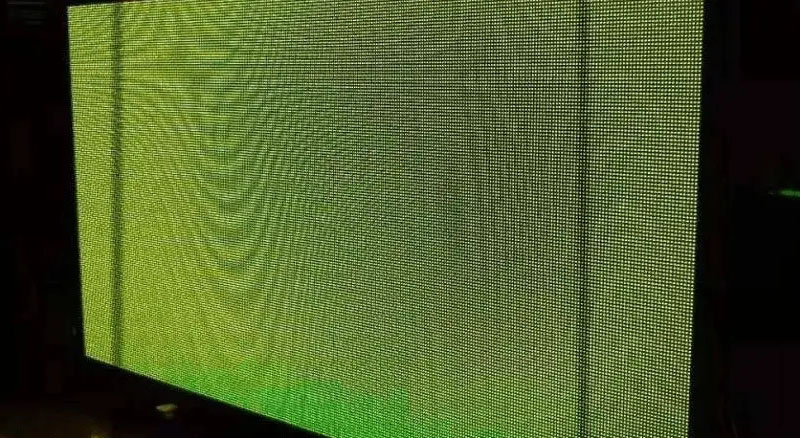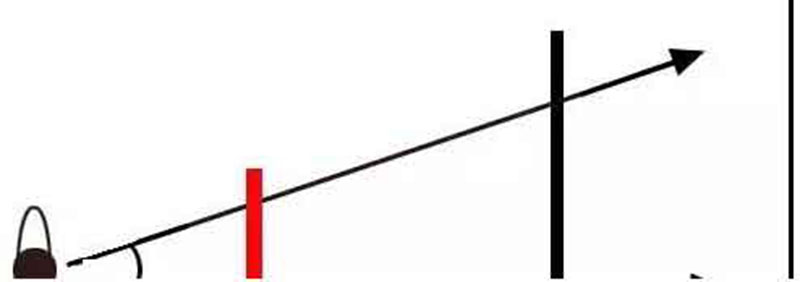LED displays are now available everywhere, whether it is in indoor shopping mall center, outdoor advertising, stage performances and conference rooms. When we shoot the screen in the LED display with a camera, many people have encountered the image that there will be ripples or stripes, which affects the image quality. What are such stripes? How did it happen? Is there any solution?
What is LED Display Moiré Pattern

Moiré patterns (also known as water ripple patterns) appear as irregular, arc-shaped streaks. They make the image look like it has irregular water ripples. Simply put, moiré patterns occur when two-pixel grids interfere with each other’s angles and frequencies. This causes the light and dark parts of the grids to overlap, creating a patterned effect.
The reason why LED displays create moiré patterns

Moiré patterns are the result of the beat frequency principle. Mathematically, when two sine waves of close frequencies are combined, the amplitude of the resulting signal changes according to the difference in frequencies.
This principle is widely used in radio, television, and communications for frequency conversion and modulation. It also applies to spatial frequencies. When stripes with slightly different spatial frequencies overlap, the overlap gradually shifts due to the difference in the strip spacing, creating a beat phenomenon.
If the spatial frequency of the pixels of a CCD (CMOS) sensor is close to the spatial frequency of the stripes in the image, moiré patterns can occur. To eliminate moiré, the resolution of the lens should be much lower than the spatial frequency of the sensor.
When this condition is met, stripes similar to those in the sensor won’t appear in the image, preventing moiré. Some digital cameras incorporate low-pass filters to reduce moiré by filtering out higher spatial frequencies in the image, which can reduce image sharpness.
A low-pass filter is essentially a not-so-smooth, transparent thin film that slightly blurs the image and reduces most potential interference (moiré) in photos.
Film does not have regularly spaced pixels, so it doesn’t have a fixed spatial frequency and won’t produce moiré!
LED displays Moiré Pattern Reason
LED displays are made of uniformly arranged dot matrix light-emitting tubes, creating a high-brightness, large non-luminous area similar to Pattern 1.

When captured by cameras with CCD or CMOS sensors that form an image similar to Pattern2, the overlapping of these images creates moiré patterns.
- Pixel arrangement: Moiré patterns can be caused by the difference between the arrangement of LED pixels and the perception of the observer. It can cause visual interference on the sensors of cameras or recording devices.
- Resolution Difference: Moiré can occur when two grids with different resolutions overlap.For example, when the pixel density of a display doesn’t match the resolution perceived by a camera or observer.
- Angle difference: Interference can occur when two grids are superimposed at different angles. It is especially noticeable when there is an angular difference between the display and the observer.
How To reduce moiré patterns in LED displays

reduce moiré patterns in LED displays
To reduce moiré patterns in LED displays, we can do these way:
- Change the focal length of the lens: by using different lenses or settings to alter or eliminate moiré patterns.
- Place an optical treatment screen in front of the display: This screen made of special materials, disperses the light from each pixel to reduce graininess and pixel lattice effects, eliminating the conditions for moiré.
- Change the camera angle: Since shooting angles can cause moiré, rotating the camera to find a suitable position can prevent it.
- Adjust the focus: A sharp focus that brings out high detail can cause moiré, so softening the focus can eliminate it.
- Move the camera position: Moving the camera left, right, up, or down can help minimize moiré.
- Use a filter in front of the CCD: Placing a filter directly in front of the CCD can match the exposure to the spatial frequency, filtering out high spatial frequencies in the image and reducing moiré.
- Use a high refresh rate PWM driver IC: It can increase the refresh rate of the LED display. Standard LED displays can go up to 1920Hz, and small-pitch LED displays can go up to 3840Hz, further reducing moiré effects.
Why Choose our high-refresh LED displays for reducing moiré
For our high-refresh LED displays, here’s how they eliminate moiré:
- Deepen the design of the driving circuit.
- They use a unique control system software.
An optical film is fixed on the surface of the LED light-emitting tubes. This film, which is made of special materials, meets the requirements of television filming in terms of transparency and tint.
The light from the tubes is processed by the optical film to filter out stray light, and the light is uniformly magnified over the surface of the film, turning point light into area light.
It changes the spatial frequency of the screen and forms a continuous, high-resolution image on the surface of the optical film, reducing or eliminating moiré patterns. With this treatment, cameras can capture moiré-free images from any angle, position, or focal length.
Benefits of our high refresh rates LED display
- Zoom and close-up shots without moiré.
- The image is clear, smooth and detailed.
- There’s no jitter, water ripples or screen flicker.
- Colors are true to life with excellent image restoration.
- Brightness is uniform across the screen.
- Low grayscale performance is exceptional, with no mosaic effect.
- Color temperature remains consistent under different lighting conditions.
Conclusion:
If you want to reduce the LED moiré phenomenon, you need to improve the refresh rate of the LED display. You can use high refresh PWM driver IC, and then configure the video processor, you can improve the refresh rate of LED display to a large extent, even up to 3840 Hz. i.e., you can effectively solve the phenomenon of scanning patterns.
You also can choose GDHANHENG high refresh used LED display, both improves the performance and reduce the cost, if you need it, please feel free to contact us!
FAQs:
How to change the interaction between a camera’s CCD and the grating structure of an LED display?
To change the interaction between a camera’s CCD and an LED display’s grating structure to prevent moiré patterns:
- Reduce the resolution of the LED display: It ensures that the image doesn’t have stripes close to those of the sensor, thus avoiding moiré.
- Install low-pass filters in digital cameras: it can filter out higher spatial frequencies from the image. This can reduce moiré, but can also reduce image sharpness.
- Use sensors with higher spatial frequencies in digital cameras: it can exceed the pixel grid of the LED display and reduce the risk of moiré.
Film does not have a regular pixel distribution or a fixed spatial frequency, so it doesn’t produce moiré. Moiré is a digital problem caused by the interaction between the digital sensor and the pixel image of the LED screen.
How can I change the relative value of the CCD and LED display grating structure?
To change the relative values between the CCD of a camera and the dot pattern of an LED display:
- Change the camera angle. By rotating the camera and slightly changing its shooting angle, you can eliminate or reduce moiré patterns.
- Move the camera position. Moving the camera left, right, up, or down can help eliminate or reduce moiré.
- Adjust the camera focus. Too sharp a focus and too much detail in fine patterns can cause moiré. Slightly adjusting the focus settings can change the clarity and help eliminate moiré patterns.
- Change the focal length of the lens. Using different lenses or focal length settings can eliminate or reduce moiré patterns.
LED displays consist of individually illuminated pixels with noticeable non-luminous black areas between them. By finding ways to illuminate these black areas or reduce the brightness difference between them and the illuminated pixels, you can naturally reduce or even eliminate moiré.
Is there a way to turn the LED display into a bright black area?
Yes, it’s possible to make the non-luminous black areas of an LED display emit light. COB (Chip On Board) packaging technology for LED displays can easily achieve this.
When comparing COB and SMD LED displays, COB displays have a soft, uniform light that looks like a continuous light source, while SMD LED displays have individual, separate points of light. The COB package encapsulates many light pixels together to form an entire light area, unlike the SMD package, which encapsulates each light pixel separately as individual light points.



